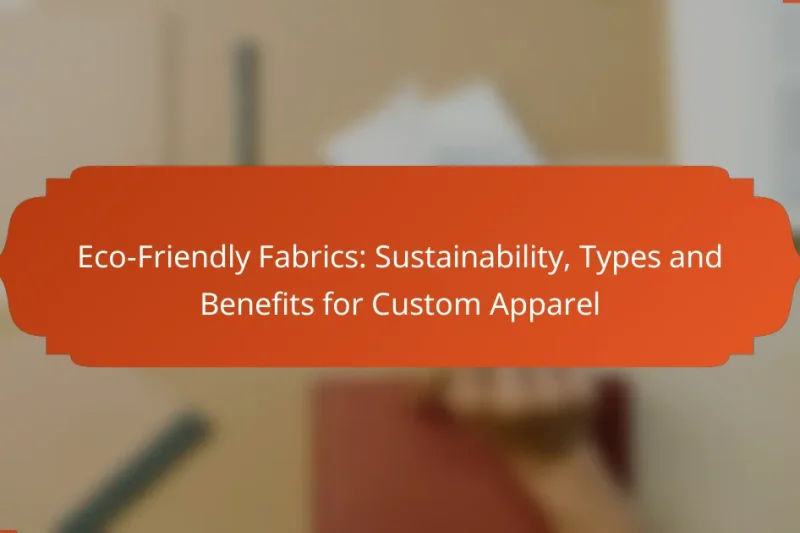When choosing between cotton and polyester, it’s essential to consider the specific needs of your project. … Cotton vs. Polyester: Which Is Better and When to UseRead more
Quality Fabric in Custom Apparel
When creating custom apparel, selecting the right fabric is crucial for achieving the desired comfort, durability, and aesthetic appeal. Options like cotton, polyester, wool, linen, and silk each bring unique advantages tailored to specific needs and uses. By prioritizing high-quality materials, you can enhance the overall experience and longevity of your garments, ensuring they meet both functional and stylistic requirements.
Fabric Weight: Importance, Impact and Selection for Custom Apparel
Fabric weight plays a vital role in determining the quality and performance of custom apparel, influencing … Fabric Weight: Importance, Impact and Selection for Custom ApparelRead more
Eco-Friendly Fabrics: Sustainability, Types and Benefits for Custom Apparel
Eco-friendly fabrics for custom apparel are designed to minimize environmental impact through sustainable and ethical production … Eco-Friendly Fabrics: Sustainability, Types and Benefits for Custom ApparelRead more
Fabric Quality: Evaluation Methods, Budget Tips and Key Indicators
Evaluating fabric quality is essential for ensuring the right choice for your projects, as it involves … Fabric Quality: Evaluation Methods, Budget Tips and Key IndicatorsRead more
What are the best fabrics for custom apparel?
The best fabrics for custom apparel depend on the intended use, comfort, and durability. Common choices include cotton, polyester, wool, linen, and silk, each offering unique benefits suited for different applications.
Cotton for breathability
Cotton is a popular choice for custom apparel due to its excellent breathability and softness. It allows air circulation, making it ideal for warm weather and casual wear.
When selecting cotton, consider options like combed or organic cotton for added comfort and sustainability. Avoid blends with synthetic fibers if breathability is a priority.
Polyester for durability
Polyester is known for its strength and resistance to shrinking and stretching, making it a durable option for custom apparel. It is often used in athletic wear due to its moisture-wicking properties.
When choosing polyester, look for high-quality blends that enhance comfort while maintaining durability. Be cautious of lower-quality polyester that may feel less breathable.
Wool for insulation
Wool is an excellent fabric for custom apparel designed for colder climates, offering natural insulation and moisture-wicking properties. It helps regulate body temperature, keeping you warm without overheating.
Consider merino wool for a softer, finer option that is less itchy and more comfortable against the skin. Avoid using wool in warmer conditions, as it may retain too much heat.
Linen for comfort
Linen is favored for its lightweight and breathable qualities, making it perfect for summer apparel. Its natural fibers provide a relaxed fit and a unique texture that adds character to custom pieces.
When selecting linen, opt for higher thread counts for better durability and softness. Be aware that linen wrinkles easily, which may be a consideration for some styles.
Silk for luxury
Silk is synonymous with luxury and elegance, making it a premium choice for custom apparel. Its smooth texture and natural sheen elevate garments, making them suitable for formal occasions.
When choosing silk, consider its weight and weave, as heavier silks can be more durable. However, be cautious with care instructions, as silk often requires delicate handling and cleaning.
How to choose fabric for custom clothing?
Choosing fabric for custom clothing involves understanding the garment’s purpose, the climate, and the desired look and feel. Prioritize fabric types that align with your specific needs, such as comfort, durability, and style.
Consider the garment type
The type of garment significantly influences fabric selection. For example, lightweight cotton is ideal for casual shirts, while heavier wool is better suited for tailored suits. Understanding the intended use—whether it’s for everyday wear, formal occasions, or athletic activities—helps narrow down suitable fabrics.
Additionally, consider the construction techniques involved. Some fabrics work better with specific styles; for instance, structured fabrics are essential for blazers, while flowy materials are preferred for dresses.
Evaluate climate and season
Climate and seasonality play a crucial role in fabric choice. In warmer climates, breathable fabrics like linen or cotton are preferable, while in colder regions, materials such as wool or fleece provide necessary warmth. Choosing the right fabric can enhance comfort and functionality throughout the year.
Seasonal trends also affect fabric selection. For summer, lighter colors and airy fabrics are popular, while winter often calls for heavier, darker materials that retain heat.
Assess fabric weight and drape
Fabric weight and drape are essential considerations for achieving the desired silhouette and comfort. Lightweight fabrics, such as chiffon or georgette, offer a soft drape suitable for flowing garments, while heavier fabrics like denim or canvas provide structure and durability.
When assessing drape, consider how the fabric falls and moves. A fabric with good drape will enhance the overall look of the garment, while a stiffer fabric may be better for structured designs. Testing fabric samples can help determine the best fit for your project.
What are the benefits of high-quality fabric in custom apparel?
High-quality fabric in custom apparel offers significant advantages, including enhanced comfort, improved durability, and better aesthetic appeal. Choosing the right fabric can elevate the overall experience and longevity of the garment, making it a worthwhile investment.
Enhanced comfort and fit
High-quality fabrics are often softer and more breathable, which contributes to a better fit and overall comfort. Natural fibers like cotton, linen, and wool tend to wick moisture away from the body, keeping the wearer cool and dry.
When selecting fabric, consider the weight and stretch. Lightweight materials are ideal for warmer climates, while heavier fabrics provide warmth in cooler conditions. Always check for a good fit, as even the best fabric can feel uncomfortable if the garment is poorly tailored.
Improved durability and longevity
Durable fabrics withstand wear and tear better than lower-quality options, ensuring that custom apparel lasts longer. Fabrics like denim and canvas are known for their strength, while blends can enhance resilience against fading and stretching.
To ensure longevity, look for fabrics with a high thread count and those that are treated for stain resistance. Regular care and proper washing techniques can further extend the life of high-quality garments, making them a smart choice for everyday wear.
Better aesthetic appeal
The visual quality of high-quality fabrics can significantly enhance the overall look of custom apparel. Rich colors, unique textures, and elegant draping can elevate a simple design into something striking and sophisticated.
When choosing fabric, consider how it will hold dye and its ability to maintain color over time. Fabrics like silk and high-quality cotton often provide a luxurious finish that can make custom pieces stand out in any wardrobe.
How does fabric quality affect custom apparel pricing?
Fabric quality significantly influences the pricing of custom apparel. Higher quality materials typically lead to increased costs due to their superior properties, while also offering benefits that can justify the investment over time.
Higher quality fabrics increase costs
When selecting custom apparel, opting for higher quality fabrics often results in a higher initial price. Fabrics such as organic cotton, silk, or high-performance synthetics can cost substantially more than standard materials. This price difference can range from 20% to 100% depending on the fabric type and supplier.
It’s essential to consider the source of the fabric as well. Specialty suppliers may charge more for unique or sustainable materials, which can elevate overall production costs. However, these fabrics often provide better aesthetics and comfort, making them worth the investment for many consumers.
Long-term savings from durability
Investing in higher quality fabrics can lead to long-term savings due to their durability. While the upfront cost is higher, quality materials tend to withstand wear and tear better, reducing the need for replacements. For example, a well-made garment from high-quality fabric can last several years longer than one made from cheaper materials.
Additionally, quality fabrics often require less maintenance, such as fewer washes or less frequent repairs. This can translate into savings on laundry and alteration costs over time, making the initial investment in quality fabric a financially sound decision for custom apparel.
What are the top brands for custom apparel fabrics?
The leading brands for custom apparel fabrics include Liberty Fabrics, Robert Kaufman, and Milliken. Each brand specializes in unique fabric types that cater to different design needs, ensuring quality and durability in custom clothing.
Liberty Fabrics for prints
Liberty Fabrics is renowned for its vibrant and intricate printed fabrics, often featuring floral and paisley designs. These fabrics are ideal for creating eye-catching custom apparel, such as dresses and blouses, that stand out in any wardrobe.
When selecting Liberty Fabrics, consider the weight and drape of the material, as these factors can significantly affect the final garment’s look and feel. Their cotton lawn is particularly popular for lightweight summer wear.
Robert Kaufman for cottons
Robert Kaufman specializes in high-quality cotton fabrics that are perfect for custom apparel. Their offerings include a variety of cotton types, such as quilting cotton and canvas, suitable for everything from casual shirts to structured jackets.
When choosing Robert Kaufman fabrics, pay attention to the fabric’s thread count and finish, as these elements influence softness and durability. Their cottons are often pre-shrunk, making them a reliable choice for long-lasting garments.
Milliken for performance fabrics
Milliken is a leader in performance fabrics, offering materials designed for durability and functionality. Their fabrics are often used in activewear and uniforms, providing moisture-wicking and stretch properties that enhance comfort during wear.
Consider Milliken’s fabric technology, which includes stain resistance and UV protection, making them suitable for outdoor apparel. When selecting performance fabrics, ensure they meet your specific needs for breathability and movement for optimal performance.
How to care for custom apparel fabrics?
Caring for custom apparel fabrics is essential to maintain their quality and longevity. Proper washing, drying, and storage techniques can prevent damage and fading, ensuring your garments look great for years.
Washing Instructions
When washing custom apparel, always check the care label for specific instructions. Generally, use cold water and a gentle cycle to prevent shrinking and color bleeding. Avoid harsh detergents; instead, opt for mild, fabric-friendly options.
For delicate fabrics, consider hand washing to minimize agitation. If machine washing is necessary, place garments in a mesh laundry bag to protect them from snagging or stretching.
Drying Techniques
Air drying is the best method for custom apparel, as it reduces the risk of shrinkage and damage from high heat. Lay garments flat on a clean surface or hang them to dry in a shaded area to avoid sun exposure, which can fade colors.
If using a dryer, select a low heat setting and remove items promptly to prevent wrinkles. Always check the care label, as some fabrics may require specific drying methods.
Ironing and Storage
Iron custom apparel on the lowest heat setting suitable for the fabric type. Use a pressing cloth to protect delicate materials and prevent shine. Always iron garments inside out to maintain their appearance.
For storage, keep custom apparel in a cool, dry place. Use padded hangers for delicate items and fold heavier garments to avoid stretching. Avoid overcrowding in closets to allow fabrics to breathe and maintain their shape.



